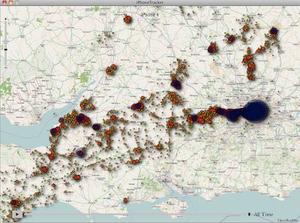Wireless snoopingCell phone privacy
Apple faces questions about an undisclosed, hidden geographical tracking file in its 3G products; the existence of the system was included in an operating system update downloaded and installed by users; a free mapping program can be downloaded to view your own history

A map showing locations generated by Warden's program // Source: github.com
Apple Corporation has been scrambling to explain the existence of a tracking file on its 3G iPhone and iPad products, and its failure to disclose the capability to users for over a year, or give the user the opportunity to opt out.
The software was surreptitiously included in an operating system update that users were encouraged to download and install.
Once installed, the program began logging location data, including time and date, and storing it in a hidden file. The discovery of the tracking functionality and its attendant hidden files were announced at the T3 conference in San Francisco by the two British researchers who discovered their existence.
The software periodically captures the cell phone’s location, gleaning that information from cell phone towers and Wi-Fi networks, then stores that data in the hidden file. Since the system uses triangulation of cell phone towers, it is not as accurate as it would be if using GPS data.
In other words, it records an area in which a person was present, but not necessarily a specific location. As a result, it would seem to show the cell user as being in an area they did not visit or transit, when the user was actually several miles away.
One of the concerns that has been expressed is that when an iPhone or iPad is synchronized with a computer, that information is transferred to the computer’s hard drive. If the security on that computer is compromised, a comprehensive record of the cell phone owner’s movements is accessible.
By default, this data is not encrypted, though the user can at any time opt to encrypt it. Most people, however, fail to do so.
Pete Warden, who worked for Apple for five years, and Alasdair Allan, the software engineers who made the discovery, have created a Web site explaining the tracking program, and Warden has created a free downloadeable program that shows the gathered data on a map. The open-source file is available in both .zip and .tar formats.
The Web page also shows sample maps drawn from the program and a FAQ (Frequently Asked Questions) section.
